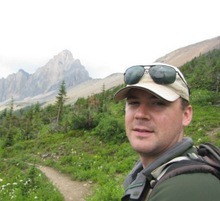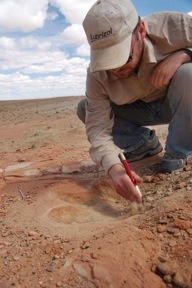Caleb comments on his research and his experience publishing with us.

PJ: Can you tell us a bit about yourself?
CB: I am the Betsy Nicholls Post-Doctoral Fellow at the Royal Tyrrell Museum of Palaeontology, located in Drumheller, Alberta, Canada. I recently (2013) obtained my PhD from the University of Toronto in the Department of Ecology and Evolutionary Biology. My research largely concentrates on dinosaurs, investigating their diversity, evolution, and growth.
PJ: Can you briefly explain the research you published in PeerJ?
CB: This research was conducted in collaboration with Dr. Matthew Vavrek, a research associate at the Royal Ontario Museum. Our paper investigates allometry, or relative growth, a process by which the proportions of an animal can change as it grows. We were particularly interested in identifying allometry in fossils and with smaller sample sizes. The paper really has two parts, the first documents the sample sizes normally used in allometry studies on different types of animals, and the second uses a dataset of Alligator skull measurements to test how small sample sizes can alter our ideas about relative growth.
PJ: What surprised you the most with these results?
CB: Maybe this should not have surprised me, but what did surprise me the most was the similarity in the samples sizes used between living vertebrates and invertebrates, and also between fossil vertebrates and invertebrates. I expected fossil samples to have smaller samples than those from living animals (and we did find this), but I did not expect the other results to be so similar. To me this highlights how samples sizes (at least for allometry) for invertebrates and vertebrates are not that different.
PJ: What kinds of lessons do you hope the public takes away from the research?
CB: The most important lesson that the public can take away from this research is the importance of museum collections. This research would not have been possible without the specimens stored in many different museums. These specimens were collected for a variety of different purposes totally unrelated to this study, but because they were made accessible they can be used in all sorts of novel projects.

PJ: Where do you hope to go from here?
CB: Although this paper puts forward some new data and ideas it is by no means a definitive result regarding sample size and allometry. Science is cumulative, and new research will continue to increase our understanding of this question. What I would be interested in seeing is how broadly applicable our results are when other datasets are examined with similar methods – particularly datasets derived from other animals and with larger sample size.
PJ: How did you first hear about PeerJ, and what persuaded you to submit to us?
CB: I first heard about PeerJ via social media (Twitter, Facebook), but also from different colleagues within my field. I performed a peer review for PeerJ and was impressed by the publishing process. I am also a proponent of open access, so for one of the next papers was ready to submit PeerJ seemed like a good option
PJ: How would you describe your experience of our submission/review process?
CB: I was very impressed with all the aspects of PeerJ publications process. The review process was quick and professional. I was surprised with the quality of the formatting. Relative to other online only open access journals, PeerJ puts more of an effort into formatting and how the final paper looks. I was also surprised with the flexibility of both the submission and page proof stages of the publication.
PJ: Did you get any comments from your colleagues about your publication with PeerJ?
CB: So far my colleagues have been positive about both the research and the choice of publishing venue. It is great to have the research open access and available to anyone who is interested.
PJ: Would you submit again, and would you recommend that your colleagues submit?
CB: Yes, I would definitely consider submitting to PeerJ again, and would recommend it to other researchers. PeerJ is a great option for affordable, fast, open access research, and I do think it will help to change the scientific publication process.
PJ: Anything else you would like to talk about?
CB: Firstly, I would like the extend a special thanks to Drs. Grant Hurlburt and Kevin Seymour for their work in obtaining and preserving much of the Alligator collection at the Royal Ontario Museum. This material is now available to other researchers investigating a variety of questions. Museums like the Royal Tyrrell Museum of Palaeontology also play an important role in making science accessible to the public, so consider paying us a visit.
Secondly, if any readers are interested in seeing more of our research, follow us (and our museums) on twitter: @Brown_Caleb_M (@RoyalTyrrell) and@MatthewVavrek (@ROMpalaeo).
PJ: In conclusion, how would you describe PeerJ in three words?
CB: Fast, Open, Science
Join Caleb Marshall Brown and thousands of other satisfied authors, and submit your next article to PeerJ.
